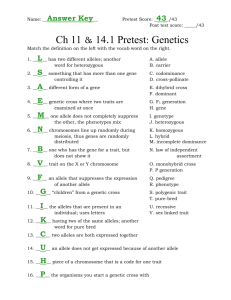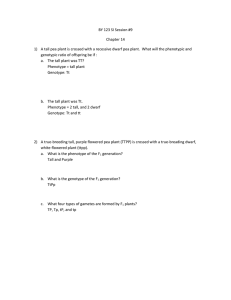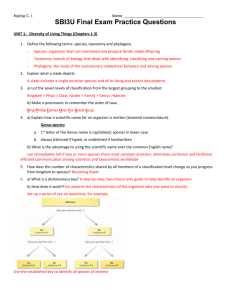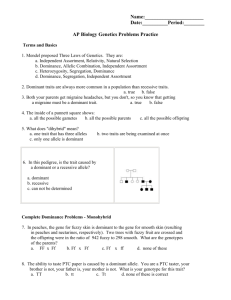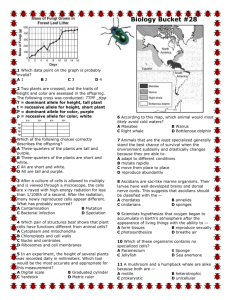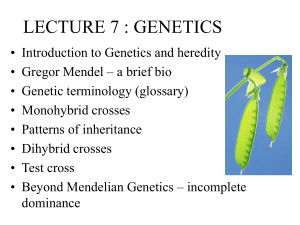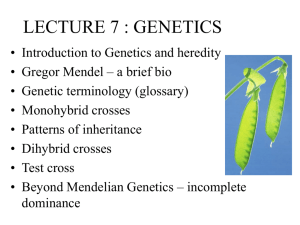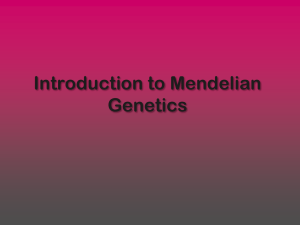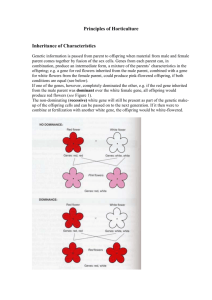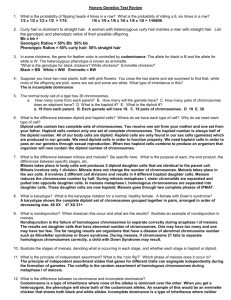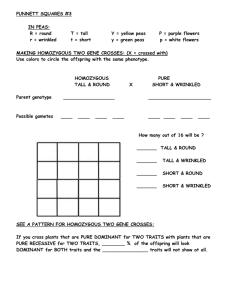TTpp - Lectures For UG-5
advertisement
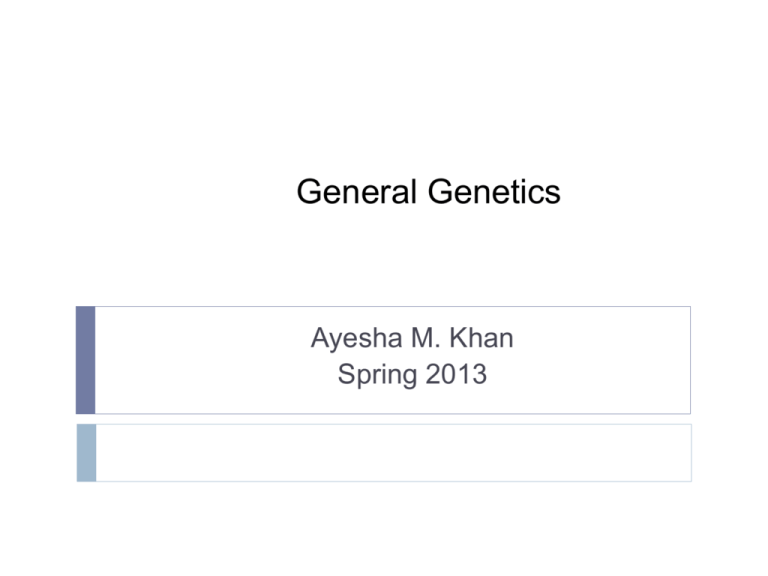
General Genetics Ayesha M. Khan Spring 2013 Test Cross Suppose you were given a tall pea plant with no information about its parents. Because tallness is a dominant trait in peas, your plant could be either homozygous (TT) or heterozygous (Tt), but you would not know which. You could determine its genotype by performing a testcross. One individual of unknown genotype is crossed with another individual with a homozygous recessive genotype for the trait in question. If the plant were homozygous (TT), a testcross would produce all tall progeny (TTxtt : all Tt); if the plant were heterozygous (Tt), the testcross would produce half tall progeny and half short progeny (Ttxtt :Tt and tt). 2 Incomplete Dominance When the heterozygote has a phenotype intermediate between the phenotypes of the two homozygotes, the trait is said to display incomplete dominance. When a trait displays incomplete dominance, the genotypic ratios and phenotypic ratios of the offspring are the same, because each genotype has its own phenotype. 3 Example of incomplete dominance examples: 1. Feather color in chickens. A cross between a homozygous black chicken and a homozygous white chicken produces F1 chickens that are gray. If these gray F1 are intercrossed, they produce F2 birds in a ratio of 1 black: 2 gray: 1 white. 2. Leopard white spotting in horses is incompletely dominant over unspotted horses: LL horses are white with numerous dark spots, heterozygous Ll horses have fewer spots, and ll horses have no spots 4 Ratios in Simple Crosses Four phenotypic ratios: 1.The 3:1 ratio: Both of the parents are heterozygous for a dominant trait (AaxAa). 2. The 1:2:1 ratio: Progeny of crosses between two parents heterozygous for a character that exhibits incomplete dominance (AaxAa). 3. The 1:1 ratio: Homozygous parent and a heterozygous parent. If the character exhibits dominance, the homozygous parent in this cross must carry two recessive alleles (Aaxaa) to obtain a 1:1 ratio, because a cross between a homozygous dominant parent and a heterozygous parent (AAxAa) produces only offspring displaying the dominant trait. For a character with incomplete dominance, a 1:1 ratio results from a cross between the heterozygote and either homozygote (Aaxaa or AaxAA). 4. The fourth phenotypic ratio is not really a ratio- all the offspring have the same phenotype. Several combinations of parents can produce this outcome. A cross between any two homozygous parentseither between two of the same homozygotes (AAxAA and aaxaa) or between two different homozygotes (AAxaa)- produces progeny all having the same phenotype. Progeny of a single phenotype can also result from a cross between a homozygous dominant parent and a heterozygote (AAxAa). 5 Multiple-Loci Crosses Dihybrid Crosses In addition to his work on monohybrid crosses, Mendel also crossed varieties of peas that differed in two characteristics (dihybrid crosses). For example, he had one homozygous variety of pea that produced round seeds and yellow endosperm; another homozygous variety produced wrinkled seeds and green endosperm. When he crossed the two, all the F1 progeny had round seeds and yellow endosperm. He then self-fertilized the F1 and obtained the following progeny in the F2: 315 round, yellow seeds; 101 wrinkled, yellow seeds; 108 round, green seeds; and 32 wrinkled, green seeds. Mendel recognized that these traits appeared approximately in a 9:3:3:1 ratio; that is, of the progeny were round and yellow, were wrinkled and yellow, were round and green, and were wrinkled and green. 6 Dihybrid Cross 9:3:3:1 ratio 7 Another example Dihybrid cross: flower color and stem length TT PP tt pp (tall, purple) Possible Gametes for parents TP and t p F1 Generation: All tall, purple flowers (Tt Pp) 8 (short, white) Dihybrid cross: flower color and stem length (shortcut) TT PP tt pp (tall, purple) (short, white) Possible Gametes for parents T P TP tp t p F1 Generation: All tall, purple flowers (Tt Pp) 9 Tt Pp Dihybrid cross F2 If F1 generation is allowed to self pollinate, Mendel observed 4 phenotypes: Tt Pp Tt Pp (tall, purple) Possible gametes: TP Tp tP tp TP TP Tp tP tp Four phenotypes observed Tall, purple (9); Tall, white (3); Short, purple (3); Short white (1) 10 (tall, purple) Tp tP tp TTPP TTPp TtPP TTPp TTpp TtPp TtPp Ttpp TtPP TtPp ttPP ttPp TtPp Ttpp ttPp ttpp Dihybrid cross 9 Tall purple TP TP 3 Tall white Tp tP tp 3 Short 1 Short 11 purple white Tp tP tp TTPP TTPp TtPP TTPp TTpp TtPp TtPp Ttpp TtPP TtPp ttPP ttPp TtPp Ttpp ttPp ttpp Phenotype Ratio = 9:3:3:1 Dihybrid cross: 9 genotypes Genotype ratios (9): 1 TTPP 2 TTPp 2 TtPP 4 TtPp 1 TTpp 2 Ttpp 1 ttPP 2 ttPp 1 ttpp 12 Four Phenotypes: Tall, purple (9) Tall, white (3) Short, purple (3) Short, white (1) Relation of gene segregation to meiosis There’s a correlation between the movement of chromosomes in meiosis and the segregation of alleles that occurs in meiosis 13 The Principle of Independent Assortment The principle of independent assortment (Mendel’s second law): This principle states that alleles at different loci separate independently of one another. The principle of segregation states that the two alleles of a locus separate when gametes are formed. 14 Branch diagram 15 Dihybrid Test Cross 16 Trihybrid crosses Crosses including three characters: In one trihybrid cross, Mendel crossed a pure-breeding variety that possessed round seeds, yellow endosperm, and gray seed coats with another pure-breeding variety that possessed wrinkled seeds, green endosperm, and white seed coats. 17 Trihybrid cross: 18 Observed and Expected ratios When two individuals of known genotype are crossed, we expect certain ratios of genotypes and phenotypes in the progeny; these expected ratios are based on the Mendelian principles of segregation, independent assortment, and dominance. The ratios of genotypes and phenotypes actually observed among the progeny, however, may deviate from these expectations. 19 The Goodness-of-Fit Chi-Square Test Differences between observed and expected ratios can arise by chance. The goodness-of-fit chi-square test can be used to evaluate whether deviations between observed and expected numbers are likely to be due to chance or to some other significant factor. The chi-square test cannot tell us whether a genetic cross has been correctly carried out, whether the results are correct, or whether we have chosen the correct genetic explanation for the results. What it does indicate is the probability that the difference between the observed and the expected values is due to chance. At the end of the chi square, we will retain or reject the null hypothesis. If we retain the null hypothesis, we can say these results could have been caused by chance (but most scientists prefer the phrase “inconclusive result”). If we reject the null hypothesis, we can say that it is unlikely that chance alone could not have resulted in these numbers. 20 Degrees of freedom (df) = n-1 where n is the number of classes Cutoff value= .05 probability level. If the probability of chance being responsible for the deviation is greater than or equal to .05, it is accepted that chance may be responsible for the deviation between the observed and the expected values. When the probability is less than .05, it is assumed that chance is not responsible and a significant difference exists. 21 By statistical convention, we use the 0.05 probability level as our critical value. If the calculated chi-square value is less than the 0 .05 value, we accept the hypothesis. If the value is greater than the value, we reject the hypothesis. 22 Penetrance and Expressivity Penetrance is defined as the percentage of individuals having a particular genotype that express the expected phenotype. For example, if we examined 42 people having an allele for polydactyly and found that only 38 of them were polydactylous, the penetrance would be 38/42 0.90 (90%). Expressivity is the degree to which a character is expressed. Some polydactylous persons possess extra fingers and toes that are fully functional, whereas others possess only a small tag of extra skin. Read the following article: http://www.nature.com/scitable/topicpage/phenotype-variability-penetrance-andexpressivity-573 23
